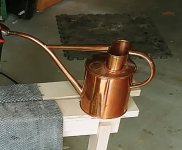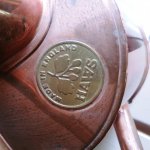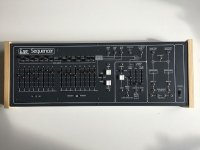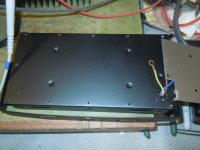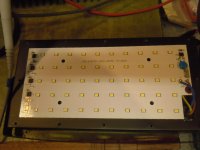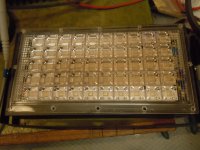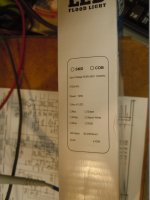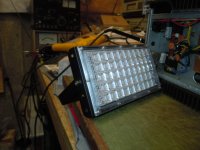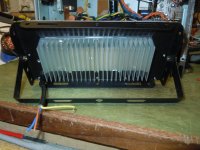Not today but a couple weeks ago I picked up this lovely handcrafted Haws watering can. It was early morning on the 50km yard sale, 5 bucks I could not even try beating her down. I later priced it at around $120 Can.
Attachments
That's a really nice watering can!
I just bought an "Applied Physics 428C DC Clip-on Milliammeter" off Ebay. God, I'm stupid. I keep buying stuff there in hopes it will work. Fingers crossed on this one. I have a spare probe, so this should work out. The only sad thing is this. The real HP 428B has a 1 mA full scale range. This newer solid state version is 10 mA FS at best. Looks like it has a 2 A FS range where the 428B has a 10A FS range. Now for the kicker ... the HP 428B is tube based with an analogue meter and both instruments use the same probe! It looks like it will out-perform the newer solid state version easily. At least they retained the deguassing port on the back of the instrument.
There is only one reason I am looking to replace the old HP 428B meters. They are huge compared to everything else on the bench. Oddly enough, I prefer the analogue meter, but that had to go or the new instrument would be close to the same size as the original.
-Chris
I just bought an "Applied Physics 428C DC Clip-on Milliammeter" off Ebay. God, I'm stupid. I keep buying stuff there in hopes it will work. Fingers crossed on this one. I have a spare probe, so this should work out. The only sad thing is this. The real HP 428B has a 1 mA full scale range. This newer solid state version is 10 mA FS at best. Looks like it has a 2 A FS range where the 428B has a 10A FS range. Now for the kicker ... the HP 428B is tube based with an analogue meter and both instruments use the same probe! It looks like it will out-perform the newer solid state version easily. At least they retained the deguassing port on the back of the instrument.
There is only one reason I am looking to replace the old HP 428B meters. They are huge compared to everything else on the bench. Oddly enough, I prefer the analogue meter, but that had to go or the new instrument would be close to the same size as the original.
-Chris
Found a copy of Собаче Сердтсе (A Dog's Heart) on DVD in a Finnish shop selling much stuff from Russia.
This is one of the best movies ever made and is based on the insanely crazy story by Michail Bulgakov, the guy who is mosty famous for Master & Margarita.
This is one of the best movies ever made and is based on the insanely crazy story by Michail Bulgakov, the guy who is mosty famous for Master & Margarita.
Last edited:
Put a deposit on a kit replica of the classic ARP 1601 Sequencer, the perfect accessory to the TTSH (2600 synthesizer kit) ordered awhile back. Both should arrive soon. I can't wait.
Just 16 steps ... When my MFOS sequenzer is finished it will have 32 steps
 .
.Who made the replica? Behringer?? And where id you get the TTSH?
I did look at the MFOS and a few others, but decided on the 1601.
Both replicas are available in various configurations from Synthcube.com:
TTSH 2600 synthesizer clone
1601 sequencer clone
Both replicas are available in various configurations from Synthcube.com:
TTSH 2600 synthesizer clone
1601 sequencer clone
A pair of 50W LED Floodlights from CESDEALS. These work if you have a 220 ~ 240 VAC AC supply. So once I figured that out I attempted to see if I could rearrange the LEDS for 120 VAC. It uses four FM3041EDS driver chips and the data sheet is all in Chinese or Japanese, and I can't read it. Would love an English translation.
Running the panel out of the case, I discovered that the PCB is an aluminium type used for dissipating heat. The ground lead was just free under this PCB assembly and the whole thing was loose inside the enclosure. Hmm, not right. So the holes were drilled outwhere they were already marked. Heat sink grease was applied between the PCB and case and the whole works screwed down. Now after a short run time I am measuring the case temperature at 71 °C, the driver chips are sitting at 63.2 °C and the LED chips are around 65 °C. It is bright. I'm having problems seeing now even after the short time needed to take the readings.
You can see the ratings are 85V ~ 265 V. (it is 185V ~ 265V). Next, screws out of the lens, then how the board was found. Finally, looky, there's the ground! I had measured earlier and found the ground to case open. This was before I disturbed the unit in any way. The open ground was the prime reason I opened it up, secondarily to see if it could be modified to run on 120 VAC that we have in North America. The seller is based here.
I wonder. How long will the front cover / lens last at these temperatures. Especially once I block the airflow to the front of the LED panel. How hot were things going to be if the heat sink grease wasn't applied and teh board screwed down. I guess I'll install the cover and run it while taking temperature readings from the mounting frame.
-Chris
Running the panel out of the case, I discovered that the PCB is an aluminium type used for dissipating heat. The ground lead was just free under this PCB assembly and the whole thing was loose inside the enclosure. Hmm, not right. So the holes were drilled outwhere they were already marked. Heat sink grease was applied between the PCB and case and the whole works screwed down. Now after a short run time I am measuring the case temperature at 71 °C, the driver chips are sitting at 63.2 °C and the LED chips are around 65 °C. It is bright. I'm having problems seeing now even after the short time needed to take the readings.
You can see the ratings are 85V ~ 265 V. (it is 185V ~ 265V). Next, screws out of the lens, then how the board was found. Finally, looky, there's the ground! I had measured earlier and found the ground to case open. This was before I disturbed the unit in any way. The open ground was the prime reason I opened it up, secondarily to see if it could be modified to run on 120 VAC that we have in North America. The seller is based here.
I wonder. How long will the front cover / lens last at these temperatures. Especially once I block the airflow to the front of the LED panel. How hot were things going to be if the heat sink grease wasn't applied and teh board screwed down. I guess I'll install the cover and run it while taking temperature readings from the mounting frame.
-Chris
Attachments
Two complete sets of Bondhus T-handle allen wrenches (aka "hex keys"). I've wanted to get some of these for years since I use 18-8 stainless socket head screws almost exclusively in my audio builds. Not cheap at $90 US, but as the saying goes: buy the good stuff and you only cry once.
@Cal: a "spam lamb" and a "lego lamb"
Sorry; I couldn't resist...
@Cal: a "spam lamb" and a "lego lamb"

Sorry; I couldn't resist...
Attachments
Hi amplidude,
... and a bright light appeared on the bench for all to see and draw comfort from ...
The back of the the frame is holding at 57 °C You can't touch it for more than a second. Damn, that's hot!
I'd better do the other one or it won't be long for the world. I'm wondering if attaching a heat sink to the back might be a good idea.
-Chris
... and a bright light appeared on the bench for all to see and draw comfort from ...
The back of the the frame is holding at 57 °C You can't touch it for more than a second. Damn, that's hot!
I'd better do the other one or it won't be long for the world. I'm wondering if attaching a heat sink to the back might be a good idea.
-Chris
Okay, so I put a heat sink on the other one. It's running at 67°C. The heat sink, the frame - all of it. That's just nuts, man! I bet the other one is hotter if I measured it in the same place.
Yeah, just touched the end of the heat sink fins, still too hot to touch even there! What do I have to do, attach fans as well? Someone didn't consider the thermal realities when they designed this. Image the way these come, the LEDs and driver chips are sitting on an aluminum core PC board. That is sitting loose inside a cavity with zero ventilation to prevent water entry (they are advertised as perfect for outdoor use). I can't imagine how hot the board is running in that state.
-Chris
Yeah, just touched the end of the heat sink fins, still too hot to touch even there! What do I have to do, attach fans as well? Someone didn't consider the thermal realities when they designed this. Image the way these come, the LEDs and driver chips are sitting on an aluminum core PC board. That is sitting loose inside a cavity with zero ventilation to prevent water entry (they are advertised as perfect for outdoor use). I can't imagine how hot the board is running in that state.
-Chris
Yup, you hit the nail right on the head.
These are going into the garage running off a step-up transformer. They put out a lot of light, and they dissipate a little over 50 watts each.
I don't know what the failure mode will be for those lights that are left stock, but I do know they will simply run so hot that they will dim quickly compared to the normal life. But how hot they actually run? No idea. I hope they don't ignite the plastic lens!
-Chris
These are going into the garage running off a step-up transformer. They put out a lot of light, and they dissipate a little over 50 watts each.
I don't know what the failure mode will be for those lights that are left stock, but I do know they will simply run so hot that they will dim quickly compared to the normal life. But how hot they actually run? No idea. I hope they don't ignite the plastic lens!
-Chris
This one doesn't, and I was surprised. There is no way this would pass ULC! it is CE approved, lead free and recyclable. I have my doubts on that score as well.
With the ground soldered in place, mounting with a heat sink using heat sink grease, it might pass. They would need a warning about the operating temperature still.
-Chris
With the ground soldered in place, mounting with a heat sink using heat sink grease, it might pass. They would need a warning about the operating temperature still.
-Chris
I am now on my third 100 watt outdoor flood. They are different than yours, and the two last ones are different from the first.
The first unit had a sealed can "LED power supply" wired to a chip on substrate "100 watt LED" which has 10 rows of 10 series LED chips mounted on a square substrate about 30 mm on a side. The entire back of the unit was a die cast pot metal finned heat sink which got quite warm, but you could hold your hand on it. The unit was operated 8 to 10 hours a per day at night for about a year until it died. First one row of LED's went out, then 4 rows, then all of them. The power supply still worked.
The second unit was a cost reduced version, and somewhat cheaper. The housing was much thinner, and lighter. There were two "50 watt" LEDs, mush the same as those in the first unit only slightly smaller. Each was wired to it's own LED power supply. It got too hot to touch. Again it lived about a year.
The third unit is exactly the same as the second. The light sensor module that operated unit number 2 seems to have shorted out, so unit #3 has been on continuously for about a year and a half. Maybe that's the cure, don't turn them off.
The first unit had a sealed can "LED power supply" wired to a chip on substrate "100 watt LED" which has 10 rows of 10 series LED chips mounted on a square substrate about 30 mm on a side. The entire back of the unit was a die cast pot metal finned heat sink which got quite warm, but you could hold your hand on it. The unit was operated 8 to 10 hours a per day at night for about a year until it died. First one row of LED's went out, then 4 rows, then all of them. The power supply still worked.
The second unit was a cost reduced version, and somewhat cheaper. The housing was much thinner, and lighter. There were two "50 watt" LEDs, mush the same as those in the first unit only slightly smaller. Each was wired to it's own LED power supply. It got too hot to touch. Again it lived about a year.
The third unit is exactly the same as the second. The light sensor module that operated unit number 2 seems to have shorted out, so unit #3 has been on continuously for about a year and a half. Maybe that's the cure, don't turn them off.
Hi George,
It should be interesting to see how long these ones last. I installed the heat sink on the other one and tested it. Still works, still reached stupid high temperatures. There is no way I can hold my hand on the heat sink even, and this is at the tips of the fins! At least I know the heat is being transferred efficiently.
This is what they look like now. That heat sink isn't a small one. It's 15cm x 6 cm.
-Chris
It should be interesting to see how long these ones last. I installed the heat sink on the other one and tested it. Still works, still reached stupid high temperatures. There is no way I can hold my hand on the heat sink even, and this is at the tips of the fins! At least I know the heat is being transferred efficiently.
This is what they look like now. That heat sink isn't a small one. It's 15cm x 6 cm.
-Chris
Attachments
- Home
- Member Areas
- The Lounge
- And what did we buy today?
